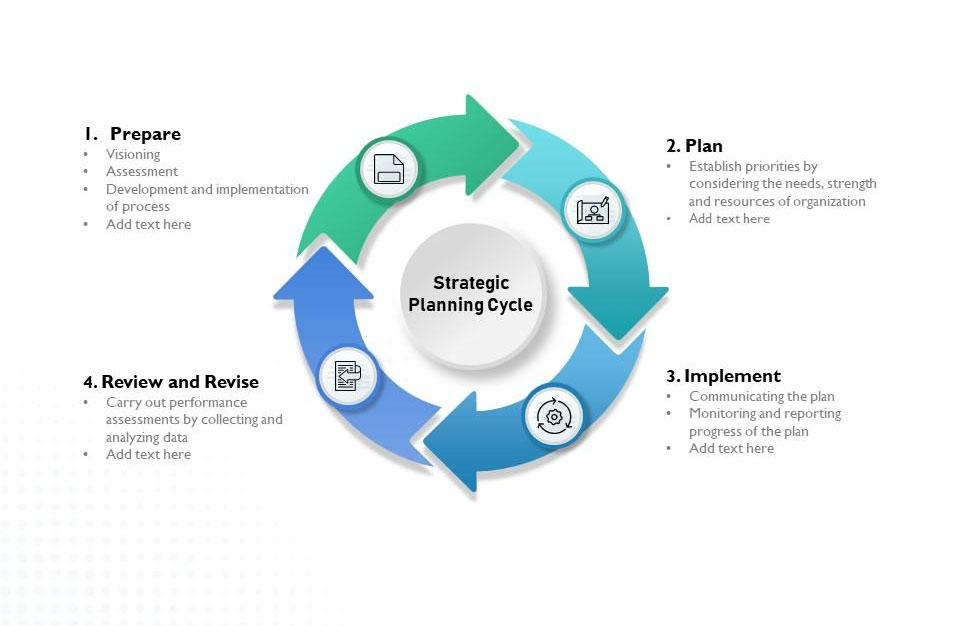Inspire growth by planning and developing new strategies:
Migration to the cloud
Nowadays, companies worldwide face more competition and new challenges daily, so an effective strategic plan should provide a more precise roadmap to achieve its business goals. We can help. Business environments are constantly changing, and it seems never-ending. Many companies are reacting to changes rather than a proactive strategic plan. From our experience, these reactive plans are only viable for short-term solutions require abundant resources and wasteful time to execute. By working with us, you will have a professional team preparing a strategic, sustainable, long-term plan. This will position your company to operate preventively as opposed to reacting. Whether you need to create an expansion plan, enhance your supply chain, or empower your employees or business leaders, we know to accompany your team in this way. Call our team to learn more!
Four Stages Of Strategic Planning Cycle For Improving Performance
If you're ready to improve your processes and pivot towards a more proficient model, contact us to schedule a free consultation! We can show you how the strategic planning cycle can fit into your current operations.

The four stages cycle of strategic planning
Prepare: this occurs when you understand the need for a strategic plan to help focus on the goals by establishing your business's direction. This stage is beneficial for organizations because it leads to developing the right goals and targets, also helping focus efforts.
Plan: a pivotal phase to establish the vision and craft values –mission statements. The mission explains why a company exists, while vision statements focus on the business's importance and hopes ahead. On the other hand, the vision is a statement directed to the internal team members. When all employees clearly understand the values of the organization they work in, it is easier to maintain everyone focused.
Review & Revise: this occurs by assessing the current Environment- Environmental scanning. Includes the process of gathering, organizing, and analyzing information to identify the organization’s strengths and weaknesses, opportunities, and threats (SWOT Analysis) so that leaders can make the best possible decisions and plans.
Implement:
Using technology's benefits, knowing that migrating to the cloud could be a great idea, but it also requires thoughtful planning. A deep understanding of how different applications and workloads migrate and run in the cloud is necessary. This process should be described as part of the strategic plan, according to different phases:
Technology is what ultimately enables agility. To achieve the most value, it's imperative to choose the right technology for the job. While identifying your focus areas, look at underlying business goals, and select a tool that helps you achieve those goals with the least amount of effort. Many Customers adopt a combination of technologies that can collaboratively support them in the pursuit of becoming agile. Choosing open technologies that can quickly increase your agility and grow with the organization is critical.
Evaluation and diagnosis of the currently available infrastructure, costs, and resources.
Choosing what apps should migrate to the cloud.
In a depth process, this should be evaluated:
Rehost: to confirm the need to change the application´s infrastructure configuration or new development to a different hardware environment.
Refactor: before confirming the migration, try to run the applications on a trial environment on the provider's cloud so that everyone can get familiarized with the news.
Revise: includes modifying or extending an existing code base to support legacy modernization requirements. After this, rehost or refactor options can be used to deploy to the cloud; In this way, the company will be able to optimize the application and take advantage of the cloud characteristics of the provider's infrastructure.
Rebuild the idea of having access to innovative features in the provider’s platform means rebuilding the solution on PaaS will be necessary. So, the code for an existing application must be discarded, and the application's re-architect must be done.
Replace: to discard an existing application, or set of them, to use a commercial software delivered as a service. The idea is to avoid investment in mobilizing a development team. Nevertheless, a disadvantage can be inconsistent data semantics, access issues, and vendor lock-in.
